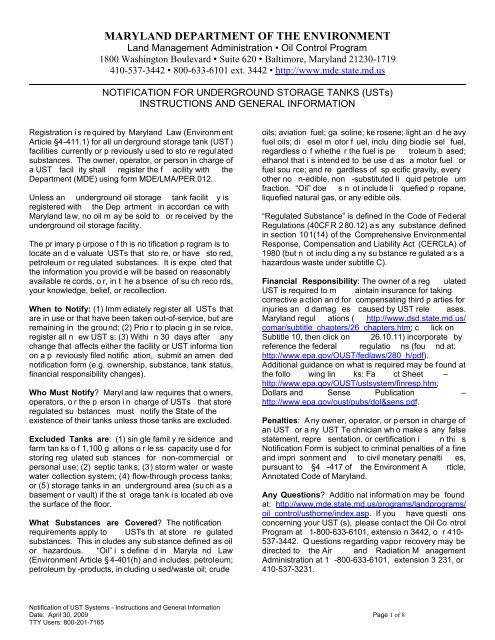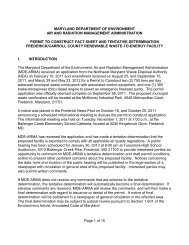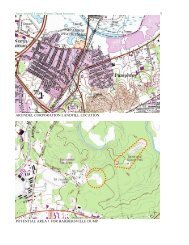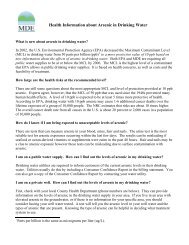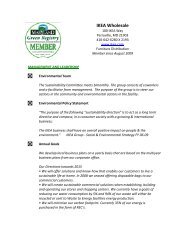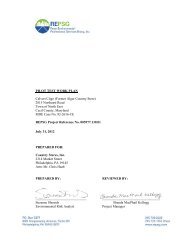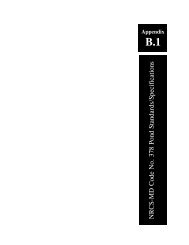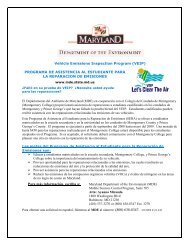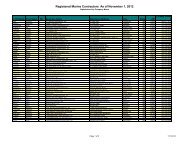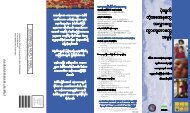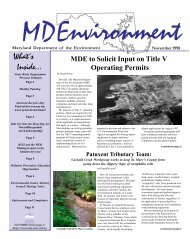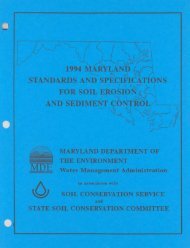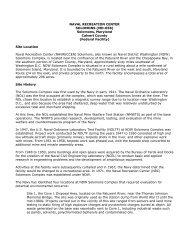Tank Registration Form Instructions - Maryland Department of the ...
Tank Registration Form Instructions - Maryland Department of the ...
Tank Registration Form Instructions - Maryland Department of the ...
Create successful ePaper yourself
Turn your PDF publications into a flip-book with our unique Google optimized e-Paper software.
MARYLAND DEPARTMENT OF THE ENVIRONMENT<br />
Land Management Administration • Oil Control Program<br />
1800 Washington Boulevard • Suite 620 • Baltimore, <strong>Maryland</strong> 21230-1719<br />
410-537-3442 • 800-633-6101 ext. 3442 • http://www.mde.state.md.us<br />
NOTIFICATION FOR UNDERGROUND STORAGE TANKS (USTs)<br />
INSTRUCTIONS AND GENERAL INFORMATION<br />
<strong>Registration</strong> i s re quired by <strong>Maryland</strong> Law (Environm ent<br />
Article §4-411.1) for all un derground storage tank (UST)<br />
facilities currently or p reviously u sed to sto re regul ated<br />
substances. The owner, operator, or person in charge <strong>of</strong><br />
a UST facil ity shall register <strong>the</strong> f acility with <strong>the</strong><br />
<strong>Department</strong> (MDE) using form MDE/LMA/PER.012.<br />
Unless an underground oil storage tank facilit y is<br />
registered with <strong>the</strong> Dep artment in accordan ce with<br />
<strong>Maryland</strong> law, no oil m ay be sold to or received by <strong>the</strong><br />
underground oil storage facility.<br />
The pr imary p urpose o f th is no tification p rogram is to<br />
locate an d e valuate USTs that sto re, or have sto red,<br />
petroleum o r reg ulated substances. It is expe cted that<br />
<strong>the</strong> information you provid e will be based on reasonably<br />
available re cords, o r, in t he a bsence <strong>of</strong> su ch reco rds,<br />
your knowledge, belief, or recollection.<br />
When to Notify: (1) Imm ediately register all USTs that<br />
are in use or that have been taken out-<strong>of</strong>-service, but are<br />
remaining in <strong>the</strong> ground; (2) Prio r to placin g in se rvice,<br />
register all n ew UST s; (3) Withi n 30 days after any<br />
change that affects ei<strong>the</strong>r <strong>the</strong> facility or UST informa tion<br />
on a p reviously filed notific ation, submit an amen ded<br />
notification form (e.g. ownership, substance, tank status,<br />
financial responsibility changes).<br />
Who Must Notify? Maryl and law requires that o wners,<br />
operators, o r <strong>the</strong> p erson i n charge <strong>of</strong> USTs that store<br />
regulated su bstances must notify <strong>the</strong> State <strong>of</strong> <strong>the</strong><br />
existence <strong>of</strong> <strong>the</strong>ir tanks unless those tanks are excluded.<br />
Excluded <strong>Tank</strong>s are: (1) sin gle famil y re sidence and<br />
farm tan ks o f 1,100 g allons o r le ss capacity use d for<br />
storing reg ulated sub stances for non-commercial or<br />
personal use; (2) septic tanks; (3) storm water or waste<br />
water collection system; (4) flow-through process tanks;<br />
or (5) storage tanks in an underground area (su ch as a<br />
basement or vault) if <strong>the</strong> st orage tank is located ab ove<br />
<strong>the</strong> surface <strong>of</strong> <strong>the</strong> floor.<br />
What Substances are Covered? The notification<br />
requirements apply to USTs th at store re gulated<br />
substances. This in cludes any sub stance defined as oil<br />
or hazardous. “Oil” i s define d in Maryla nd Law<br />
(Environment Article § 4-401(h) and includes: petroleum;<br />
petroleum by -products, in cluding u sed/waste oil; crude<br />
oils; aviation fuel; ga soline; ke rosene; light an d he avy<br />
fuel oils; di esel m otor f uel, inclu ding biodie sel fuel,<br />
regardless o f whe<strong>the</strong> r <strong>the</strong> fuel is pe troleum b ased;<br />
ethanol that i s intend ed to be use d as a motor fuel or<br />
fuel sou rce; and re gardless <strong>of</strong> sp ecific gravity, every<br />
o<strong>the</strong>r no n-edible, non -substituted li quid petrole um<br />
fraction. “Oil” doe s n ot include li quefied p ropane,<br />
liquefied natural gas, or any edible oils.<br />
“Regulated Substance” is defined in <strong>the</strong> Code <strong>of</strong> Federal<br />
Regulations (40CF R 2 80.12) a s any substance defined<br />
in section 101(14) <strong>of</strong> <strong>the</strong> Comprehensive Environmental<br />
Response, Compensation and Liability Act (CERCLA) <strong>of</strong><br />
1980 (but n ot inclu ding a ny su bstance re gulated a s a<br />
hazardous waste under subtitle C).<br />
Financial Responsibility: The owner <strong>of</strong> a reg ulated<br />
UST is required to m aintain insurance for taking<br />
corrective a ction an d for compensating third p arties for<br />
injuries an d damag es caused by UST rele ases.<br />
<strong>Maryland</strong> regul ations ( http://www.dsd.state.md.us/<br />
comar/subtitle_chapters/26_chapters.htm; c lick on<br />
Subtitle 10, <strong>the</strong>n click on 26.10.11) incorporate by<br />
reference <strong>the</strong> federal regulatio ns (fou nd at:<br />
http://www.epa.gov/OUST/fedlaws/280_h/pdf).<br />
Additional guidance on what is required may be found at<br />
<strong>the</strong> follo wing lin ks: Fa ct Sheet –<br />
http://www.epa.gov/OUST/ustsystem/finresp.htm;<br />
Dollars and Sense Publication –<br />
http://www.epa.gov/oust/pubs/dol&sens.pdf.<br />
Penalties: A ny owner, operator, or p erson in charge <strong>of</strong><br />
an UST or a ny UST Te chnician wh o make s any false<br />
statement, repre sentation, or certification i n thi s<br />
Notification <strong>Form</strong> is subject to criminal penalties <strong>of</strong> a fine<br />
and impri sonment and to civil monetary penalti es,<br />
pursuant to §4 -417 <strong>of</strong> <strong>the</strong> Environment A rticle,<br />
Annotated Code <strong>of</strong> <strong>Maryland</strong>.<br />
Any Questions? Additio nal informati on may be found<br />
at: http://www.mde.state.md.us/programs/landprograms/<br />
oil_control/usthome/index.asp. If you have questi ons<br />
concerning your UST (s), please conta ct <strong>the</strong> Oil Co ntrol<br />
Program at 1-800-633-6101, extensio n 3442, o r 410-<br />
537-3442. Q uestions regarding vapor recovery may be<br />
directed to <strong>the</strong> Air and Radiation M anagement<br />
Administration at 1 -800-633-6101, extension 3 231, or<br />
410-537-3231.<br />
Notification <strong>of</strong> UST Systems - <strong>Instructions</strong> and General Information<br />
Date: April 30, 2009 Page 1 <strong>of</strong> 8<br />
TTY Users: 800-201-7165
SPECIFIC INSTRUCTIONS<br />
Please refer to form MDE/LMA/PER .012 (4/09)<br />
Do Not Fill in Any Shaded Areas<br />
Facility ID Number: (All Pages) – If this is an existing facility, MDE has assigned an identification number<br />
to it. Insert this number where indicated on every page <strong>of</strong> this form. If this is a new facility, leave blank.<br />
Type <strong>of</strong> Notification: (Page 1)<br />
New Facility: Mark this box if this facility has never been registered with MDE.<br />
Amended: Mark this box if <strong>the</strong> facility was previously registered with MDE and you are updating<br />
information, including <strong>the</strong> installation <strong>of</strong> new underground storage tank (UST) system(s).<br />
Closure: Mark this box if one or more underground storage systems at <strong>the</strong> facility have been permanently<br />
or temporarily closed (taken out-<strong>of</strong>-service).<br />
Number <strong>of</strong> tanks at facility: Enter <strong>the</strong> total number <strong>of</strong> USTs to be registered for this facility, including all<br />
active, permanently closed, and temporarily out-<strong>of</strong>-service tanks.<br />
Number <strong>of</strong> continuation sheets attached: If you have more than five (5) USTs to be registered, copy<br />
pages 3 through 6 prior to completing and indicate <strong>the</strong> total number <strong>of</strong> additional sheets included with this<br />
Notification.<br />
I. OWNERSHIP INFORMATION (page 1):<br />
Ownership refers to <strong>the</strong> owner <strong>of</strong> <strong>the</strong> UST system. The owner’s name is <strong>the</strong> individual owner or business<br />
name registered with <strong>the</strong> <strong>Maryland</strong> <strong>Department</strong> <strong>of</strong> Assessments and Taxation. Contact person is <strong>the</strong><br />
individual <strong>the</strong> <strong>Department</strong> should contact if we have questions regarding this Notification. Do not enter<br />
any information in <strong>the</strong> OWNER I.D. block.<br />
Owner Name Change: Mark “yes” or “no” if <strong>the</strong> owner name is being changed.<br />
TYPE OF OWNER: Mark <strong>the</strong> one line that best describes <strong>the</strong> type <strong>of</strong> owner.<br />
II. LOCATION OF TANK(S) (page 1):<br />
Facility Name Change: Mark “yes” or “no” if <strong>the</strong> facility name is being changed.<br />
Facility Name or Company Site Identifier. Use this line to write in <strong>the</strong> name <strong>of</strong> <strong>the</strong> facility or company site<br />
(for example: “ABC Gasoline” or your company’s identifier for <strong>the</strong> site “Store 109”).<br />
Street Address: Use a complete street address which includes property number (such as “109 Maple<br />
Street”). No post <strong>of</strong>fice boxes, route numbers, or listings such as “at <strong>the</strong> intersection <strong>of</strong> Main and 12th<br />
Streets” will be accepted.<br />
Facility Water Supply: Mark whe<strong>the</strong>r <strong>the</strong> facility is on private or public drinking water.<br />
Facility Operator: This space is used to identify <strong>the</strong> operator if different than <strong>the</strong> owner. If facility operator<br />
is <strong>the</strong> owner, indicate “same as owner.”<br />
Primary Telephone Number: The phone number provided here is where <strong>the</strong> facility operator can be best<br />
contacted during regular business hours.<br />
Notification <strong>of</strong> UST Systems - <strong>Instructions</strong> and General Information<br />
Date: April 30, 2009 Page 2 <strong>of</strong> 8<br />
TTY Users: 800-201-7165
III. TYPE OF FACILITY (page 2) Mark only one.<br />
Aircraft Owner : Fa cility used to sup port<br />
individual o wners <strong>of</strong> aircraft pri marily for<br />
recreational use.<br />
Airline (Air Taxi): Facility used to support <strong>the</strong><br />
airline industry both for passengers or cargo.<br />
Apartment /Condo: A commercial building for<br />
multiple families.<br />
Auto Dealership: A commercial facility used to<br />
sell both retail and wholesale cars and trucks.<br />
Commercial: A fixed facility used for retail or<br />
wholesale business and not specifically defined<br />
by o<strong>the</strong>r facility types in <strong>the</strong>se instructions.<br />
Contractor: Facility used to support an owner<br />
who performs contractual services such as<br />
building, painting, construction, etc.<br />
Educational: Includes colleges, universities,<br />
secondary and elementary schools both public<br />
and privately owned.<br />
Farm/Nursery: A tract <strong>of</strong> land devoted to <strong>the</strong><br />
production <strong>of</strong> crops or raising animals, including<br />
fish.<br />
Federal Military: Owned or operated by <strong>the</strong> U.S.<br />
<strong>Department</strong> <strong>of</strong> Defense.<br />
Federal Non-Military: Owned or operated by <strong>the</strong><br />
federal government that is not Depa rtment <strong>of</strong><br />
Defense related.<br />
Fire/Rescue/Ambulance: Includes public,<br />
private or volunteer organizations.<br />
Gas Station: A commercial facility that retails<br />
gasoline to <strong>the</strong> general public.<br />
Industrial: A fixed commercial facility used for<br />
manufacturing or warehousing goods, products<br />
or industrial services.<br />
Local Government: If <strong>the</strong> Type <strong>of</strong> Owner on<br />
page 1 <strong>of</strong> this form is a Local Government, use<br />
<strong>the</strong> facility type in this section that best fits <strong>the</strong><br />
facility. If <strong>the</strong>re is no best fit, mark this line and<br />
identify <strong>the</strong> facility under “O<strong>the</strong>r” (e.g., animal<br />
control building).<br />
Marina: A facility used to store, moor or repair<br />
marine vessels.<br />
Not Listed: If <strong>the</strong> Type <strong>of</strong> Owner on page 1 <strong>of</strong><br />
this form is o<strong>the</strong>r than Government and no<br />
facility type in this section matches, mark this<br />
line and identify <strong>the</strong> facility under “O<strong>the</strong>r.”<br />
Office: A building used to house one or more<br />
businesses and workers to operate <strong>the</strong><br />
business.<br />
O<strong>the</strong>r: If no facility type in this section matches,<br />
mark this line and identify <strong>the</strong> facility.<br />
Petroleum Distributor: Facility that stores and<br />
distributes oil products in bulk.<br />
Railroad: Facility that operates solely for <strong>the</strong><br />
transportation <strong>of</strong> goods or passengers by <strong>the</strong> rail<br />
system.<br />
Residential: The dwelling <strong>of</strong> an individual and/or<br />
family and used solely for non-commercial<br />
purposes (i.e., a single family residence).<br />
State Government: If <strong>the</strong> Type <strong>of</strong> Owner on<br />
page 1 <strong>of</strong> this form is a State Government, use<br />
<strong>the</strong> facility type in this section that best fits <strong>the</strong><br />
facility. If <strong>the</strong>re is no best fit, mark this line and<br />
identify <strong>the</strong> facility under “O<strong>the</strong>r.”<br />
Store: A commercial business that retails goods<br />
to <strong>the</strong> public and is not a gas station.<br />
Public Service: Includes law enforcement<br />
agencies, local municipalities (i.e. public works,<br />
roads, refuse departments).<br />
Trucking/Transport: Facility used to provide<br />
transportation to move goods, products, and<br />
passengers over <strong>the</strong> roads.<br />
Utilities: Facilities that provide supply power,<br />
communication, water and/or sewer services.<br />
Notification <strong>of</strong> UST Systems - <strong>Instructions</strong> and General Information<br />
Date: April 30, 2009 Page 3 <strong>of</strong> 8<br />
TTY Users: 800-201-7165
IV. CONTACT PERSON IN CHARGE OF TANKS (page 2)<br />
This section sho uld be used to id entify <strong>the</strong> per son who th e <strong>Department</strong> sho uld contact re garding<br />
information on <strong>the</strong> sto rage systems. Provide <strong>the</strong> co mplete mailing address, including zip code, and th e<br />
primary phone number, fax number, and email address for contacting this person.<br />
V. FINANCIAL RESPONSIBILITY (FR) (page 2)<br />
This section is to be completed by <strong>the</strong> owner(s) <strong>of</strong> any UST system that stores motor fuels, lube oils, and<br />
bulk heating oil, including emergency generators. P ursuant to fe deral law (40CFR 280 Subpart H) and<br />
<strong>Maryland</strong> sta tutes and re gulations (§4 -409(b) <strong>of</strong> <strong>the</strong> Enviro nment Article an d COMAR 2 6.10.11), US T<br />
owners shall meet specif ic finan cial responsibility (FR) requi rements that demonstrate <strong>the</strong> owner’s<br />
insurance provision s for taking co rrective action and for comp ensating third partie s for injurie s an d<br />
damages that may ensue from UST releases. A general liability policy does not meet thi s requirement.<br />
Heating oil used for direct consumption is exempt from this requi rement and “Not Required” should be<br />
marked. Ho wever, if a heating oil US T is se rving a dual pu rpose as an em ergency generator, it must<br />
meet <strong>the</strong> F R requi rements. See pa ge one <strong>of</strong> <strong>the</strong> se instructions for fu r<strong>the</strong>r information o n appli cable<br />
statutes and regulations to ensure that your FR coverage is adequate and your certification is accurate.<br />
VI. DESCRIPTION OF UNDERGROUND STORAGE TANKS (page 3)<br />
<strong>Tank</strong> Identification Number (also found on pages 4, 5, and 6): If you are updating facility information and<br />
MDE has previously assigned a tan k number, enter that number. O<strong>the</strong>rwi se, leave blank and MDE will<br />
complete.<br />
Alternate <strong>Tank</strong> I.D. Number (also found on pages 4, 5 and 6): This line may be used by you to record <strong>the</strong><br />
tank numbers your company uses to refer to <strong>the</strong> tanks at this facility.<br />
1. Status <strong>of</strong> <strong>Tank</strong> (page 3): Please mark only one <strong>of</strong> <strong>the</strong> following.<br />
Currently In Use: UST system actively being used.<br />
Temporarily Out Of Use: An UST system not being used and has not been permanently closed<br />
according to <strong>Maryland</strong> regulations. No more than 1 inch <strong>of</strong> liquid is allowed in this system.<br />
Permanently Out Of Use: An UST system that has been properly closed according to <strong>Maryland</strong><br />
Regulations. Proper closure is <strong>the</strong> removal or filling in place <strong>of</strong> <strong>the</strong> storage system. You must<br />
complete item 8 in this section for any UST system identified as permanently out-<strong>of</strong>-use.<br />
2. Date <strong>of</strong> Installation (page 3): Report <strong>the</strong> date <strong>the</strong> storage system was installed by writing in <strong>the</strong><br />
month and year. If unsure, estimate <strong>the</strong> year.<br />
3. Total Capacity (page 3): This line is to report <strong>the</strong> maximum capacity <strong>of</strong> <strong>the</strong> storage tank (such as<br />
6,000 gallons). Piping capacity should not be reported. Identify if <strong>the</strong> storage tank is compartmented and<br />
if yes, <strong>the</strong> maximum capacity <strong>of</strong> each compartment. Identify if <strong>the</strong> storage tank is manifolded.<br />
4. <strong>Tank</strong> Construction (page 3): This section is to report tank construction materials. Mark all that apply<br />
for <strong>the</strong> tank only. Piping is covered in Section 5.<br />
Asphalt Coated or Bare Steel: This box is normally marked for older tank systems installed prior to 1985.<br />
These are tanks that are made <strong>of</strong> steel with only a thin coating <strong>of</strong> asphalt or paint, if any coating at all.<br />
Cathodically Protected Steel (Galvanic): This type <strong>of</strong> tank i s known as a STIP3 tank in which sacrificial<br />
anodes are installed as part <strong>of</strong> <strong>the</strong> UST system.<br />
Notification <strong>of</strong> UST Systems - <strong>Instructions</strong> and General Information<br />
Date: April 30, 2009 Page 4 <strong>of</strong> 8<br />
TTY Users: 800-201-7165
4. <strong>Tank</strong> Construction (page 3): This section is to report tank construction materials. Mark all that apply<br />
for <strong>the</strong> tank only. Piping is covered in Section 5.<br />
Cathodically Protecte d Steel (Imp ressed Current ): Usually a b are steel tan k that h as b een retro-fitted<br />
with an impressed current cathodic protection system.<br />
Composite Clad Steel: T his type <strong>of</strong> ta nk is made <strong>of</strong> steel <strong>the</strong>n wrapped on <strong>the</strong> outside with fiberglass.<br />
Examples <strong>of</strong> <strong>the</strong>se tanks are: Buffhide, Glasteel, High-life FRP, or ACT 100 tanks.<br />
Fiberglass Reinforced Plastic: T his type <strong>of</strong> tan k is made exclusively <strong>of</strong> fibergl ass. Ta nk manufacturers<br />
include: Xerxes, Owens Corning, and Fluid Containment.<br />
Polyethylene <strong>Tank</strong> Jacket: This is a steel tan k th at has a n ex ternal covering <strong>of</strong> materi al o<strong>the</strong>r th an<br />
fiberglass. An example <strong>of</strong> this is Total Containment.<br />
O<strong>the</strong>r: If you know <strong>the</strong> type <strong>of</strong> construction but it does not appear as an option, use this line to specify <strong>the</strong><br />
material (e.g. concrete).<br />
Double-Walled: This type <strong>of</strong> manufact ured construction is a pri mary tank within a se condary tan k in<br />
which <strong>the</strong> interstitial space can be monitored for an oil release.<br />
Excavation Liner: If <strong>the</strong> tank field has been lined to collect product for release detection, mark this box.<br />
Lined Interior: If you have a steel tank that has been entered and lined with a fiberglass type spray, mark<br />
this box. This activity is n ormally performed on a ba re steel tank over 15 yea rs <strong>of</strong> age. As <strong>of</strong> January<br />
12, 2009, lined interiors are not allowed as a repair unless <strong>the</strong> <strong>Department</strong>’s approval is received.<br />
Lined Interior with Imp ressed Current: If you have a lined steel tank with impressed current, mark thi s<br />
box. As <strong>of</strong> January 12, 2009, lined interiors are not allowed as a repair unless <strong>the</strong> <strong>Department</strong>’s<br />
approval is received.<br />
Has <strong>the</strong> tank been repaired? Mark this line “yes” if <strong>the</strong> tank has been repaired because <strong>of</strong> a leak.<br />
5. Piping Construction (page 4 ): T his section i s to rep ort pi ping mate rials con nected t o ea ch ta nk.<br />
Mark all that apply.<br />
Aboveground Piping: If piping conveying flammable or combustible liquids is above ground, it must be<br />
constructed <strong>of</strong> steel or an approved marina pipe.<br />
Bare or Galvanized Steel: This type <strong>of</strong> piping may be black iron, galvanized coated (silver color), or<br />
wrapped with no cathodic protection.<br />
Bare or Galvanized Steel -sleeved in PVC, FRP, or Plastic: Steel piping inserted into some type <strong>of</strong> plastic<br />
piping to provide corrosion protection.<br />
Copper: This type <strong>of</strong> piping is usually found on small heating oil tanks and does not have corrosion<br />
protection.<br />
Copper (CP Protected): Copper piping that is cathodically protected.<br />
Copper-sleeved in PVC, FRP, or Plastic: Copper piping inserted into some type <strong>of</strong> plastic piping to<br />
provide corrosion protection.<br />
Cathodically Protected (CP) Steel (Galvanic or Impressed Current): This type <strong>of</strong> piping is usually metal<br />
and is protected by ei<strong>the</strong>r sacrificial anodes (galvanic) or an impressed current system. These boxes may<br />
Notification <strong>of</strong> UST Systems - <strong>Instructions</strong> and General Information<br />
Date: April 30, 2009 Page 5 <strong>of</strong> 8<br />
TTY Users: 800-201-7165
5. Piping Construction (page 4 ): T his section i s to rep ort pi ping mate rials con nected t o ea ch ta nk.<br />
Mark all that apply.<br />
be marked if your Bare Steel or Galvanized piping has been upgraded with corrosion protection. These<br />
boxes are rarely used if you checked Fiberglass Reinforced Plastic or Flexible Plastic.<br />
Fiberglass Reinforced Plastic: This type <strong>of</strong> piping is specifically manufactured for underground use and is<br />
made <strong>of</strong> fiberglass. Examples <strong>of</strong> brands are: Ameron, Fibercast, and Smith Fiberglass.<br />
Flexible Plastic: This type <strong>of</strong> piping looks like a hose and is specifically manufactured for petroleum<br />
underground storage systems. The piping may be green, blue, yellow, or white. Current manufacturers<br />
include APT, Envir<strong>of</strong>lex, Titeflex, and Environ.<br />
O<strong>the</strong>r: If you know <strong>the</strong> type <strong>of</strong> piping but it does not appear as a choice listed above, use this line and<br />
specify <strong>the</strong> type.<br />
No Piping: If <strong>the</strong>re is no piping (e.g. used oil tank), mark this block.<br />
Double-walled: This type <strong>of</strong> piping is UL971 or MDE approved, has an inner wall to convey oil, and an<br />
outer wall that can allow for <strong>the</strong> detection and collection <strong>of</strong> a release from <strong>the</strong> inner wall.<br />
Double-walled with Containment Sumps: All underground piping installed, upgraded, or replaced on or<br />
after January 26, 2005 must be <strong>of</strong> this construction.<br />
Secondary Containme nt: Any type <strong>of</strong> piping that provides secondary co ntainment and is not doubl ewalled<br />
(e.g. a piping trench liner or concrete trench).<br />
6. Type <strong>of</strong> Piping (page 4): This section is used to report how <strong>the</strong> tank’s contents are moved through<br />
<strong>the</strong> piping system. Mark all that apply.<br />
Pressure: This is a piping system that delivers product under pressure to a dispenser and usually uses a<br />
submersible pump located at <strong>the</strong> storage tank. Automatic Line Leak Detectors are required and ei<strong>the</strong>r<br />
electronic or mechanical must be identified.<br />
Gravity Feed: This type <strong>of</strong> system is rare for underground tank use. Product is delivered to a dispenser<br />
or point <strong>of</strong> use by <strong>the</strong> force <strong>of</strong> gravity.<br />
Suction-No Valve at <strong>Tank</strong>: This type <strong>of</strong> piping uses a pump at <strong>the</strong> point <strong>of</strong> use to pull product to <strong>the</strong><br />
pump. A single check valve is used at <strong>the</strong> pump. If <strong>the</strong>re is a release <strong>the</strong>n suction is broken. By breaking<br />
suction <strong>the</strong> release can be detected (also known as Safe Suction).<br />
Suction-Valve at <strong>Tank</strong>: This type <strong>of</strong> piping uses a pump to pull product to <strong>the</strong> point <strong>of</strong> use. A foot or<br />
angle-check valve is used at <strong>the</strong> top <strong>of</strong> <strong>the</strong> tank. This is <strong>the</strong> most commonly used suction system (also<br />
known as U.S. Suction or Unsafe Suction).<br />
Has piping been repaired? If during <strong>the</strong> life <strong>of</strong> <strong>the</strong> underground storage system <strong>the</strong> piping has been<br />
repaired, you must mark this line “yes.”<br />
Notification <strong>of</strong> UST Systems - <strong>Instructions</strong> and General Information<br />
Date: April 30, 2009 Page 6 <strong>of</strong> 8<br />
TTY Users: 800-201-7165
7. Substance Currently or Last Stored (page 5): Please mark only one box or line per tank unless it is<br />
a compartmented tank. For compartmented tanks identified under Section VI, “Total Capacity,” Item 3A,<br />
identify <strong>the</strong> tank number and <strong>the</strong> compartment as “A” or “B” in <strong>the</strong> Alt. <strong>Tank</strong> ID Number block and identify<br />
<strong>the</strong> substance in each compartment. If your product is not listed, use <strong>the</strong> “o<strong>the</strong>r” line and specify <strong>the</strong><br />
product. All hazardous substances must be specified on <strong>the</strong> hazardous substance line.<br />
7A. On-Site Consumptive Use? (page 5): If this UST is storing heating oil that is used on-site (direct<br />
consumptive use), mark “yes.”<br />
7B. Emergency Generator? (page 5): If this UST is being used to store oil for an emergency generator,<br />
mark “yes.”<br />
8. Closing <strong>of</strong> <strong>Tank</strong> (page 5): This section i s to be comp leted for tank sy stems that hav e been taken<br />
permanently out <strong>of</strong> service.<br />
Estimated Date Last Used: This is <strong>the</strong> last date tank system was fully operational.<br />
Date <strong>Tank</strong> Closed: Indicate <strong>the</strong> date only if <strong>the</strong> tank has been closed in accordance with <strong>Maryland</strong><br />
regulations.<br />
<strong>Tank</strong> Removed from Ground? Mark “yes” or “no.” If “yes,” complete 8A and 8B. If “no,” continue to<br />
“<strong>Tank</strong> Filled with Inert Material.”<br />
<strong>Tank</strong> Filled with Inert Material? Mark “yes” or “no.” If “yes,” go to “Inert Material Used.”<br />
Inert Material Used: This line is to identify <strong>the</strong> inert material used. Material could be sand, concrete, flow<br />
ash, or some o<strong>the</strong>r slurry.<br />
Change in S ervice: If <strong>the</strong> tank on ce stored a regulated substance but is no w used for a n on-regulated<br />
substance (such as water or sewage), mark this line “yes”.<br />
8A. Site Assessment Completed? (page 5): This section is to be filled out if you completed Section 8.<br />
Mark “yes” only if a MDE inspector was at <strong>the</strong> site during tank closure.<br />
8B. Assessment Report submitted to MDE? (page 5): This section is to be filled out if you completed<br />
Section 8A. If MDE was at <strong>the</strong> site during tank closure and “Site Assessment Completed” is marked<br />
“yes”, MDE will verify if Site Assessment was submitted.<br />
9. Release Detection (page 6): This section must be completed for tanks storing motor fuels and bulk<br />
storage <strong>of</strong> all petroleum products. New or replaced USTs, including emergency generators, installed after<br />
January 12, 2009 are required to have interstitial monitoring. USTs co ntaining heating oil used for direct<br />
consumption are n ot req uired to have relea se de tection. On e p rimary m ethod and al l appli cable<br />
secondary m ethods <strong>of</strong> release dete ction bein g u sed for both tan ks an d pipi ng at this facil ity must be<br />
identified by inserting “ P” for prim ary a nd “ S” fo r se condary. Ta nk (pre cision) tightne ss te sting is not<br />
approved as a sole method <strong>of</strong> release detection for existing USTs containing motor fuels or used for bulk<br />
storage. If “O<strong>the</strong>r M ethod” is selected, it must be MDE ap proved (e.g., vap or mo nitoring). If you are<br />
unfamiliar with release detection and your system requires it, pl ease contact MDE and re quest <strong>the</strong> fact<br />
sheet, “Rel ease Detectio n for Und erground Storag e Ta nk (UST ) System” o r visit <strong>the</strong> MDE web site at:<br />
http://www.mde.state.md.us/ programs/landprograms/oil_control/usthome/oil_release.asp.<br />
Notification <strong>of</strong> UST Systems - <strong>Instructions</strong> and General Information<br />
Date: April 30, 2009 Page 7 <strong>of</strong> 8<br />
TTY Users: 800-201-7165
10. Spill and Overfill Protection (page 6):<br />
Overfill Device Installed: This is a device that will prevent an overfill or alert that an overfill is about to<br />
occur. If “yes,” select <strong>the</strong> device being used. If none <strong>of</strong> <strong>the</strong> listed devices are applicable, a description in<br />
<strong>the</strong> “O<strong>the</strong>r” box must be provided.<br />
Spill Catch Basin: This is a piece <strong>of</strong> equipment that is used on <strong>the</strong> storage tank fill. The basin is a sealed<br />
bucket and catches minor drips from <strong>the</strong> delivery hose and spillage during stick readings.<br />
11. Stage I Vapor Recovery (page 6): Thi s is required during <strong>the</strong> delive ry <strong>of</strong> product for all ga soline<br />
storage tanks with an individual storage capacity greater than 2,000 gallons.<br />
12. Stage II Vapor Recovery (page 6): This is required at any dispenser for gasoline products at<br />
facilities having a total gasoline tank capacity greater than 2,000 gallons in <strong>the</strong> following <strong>Maryland</strong><br />
jurisdictions: Anne Arundel County; Baltimore City and County; Calvert County; Carroll County; Cecil<br />
County; Charles County; Frederick County; Harford County; Howard County; Montgomery County; and<br />
Prince George’s County.<br />
VII. CERTIFICATION OF COMPLIANCE (page 7):<br />
This section is to be completed at <strong>the</strong> time <strong>of</strong> installation by <strong>the</strong> <strong>Maryland</strong>-certified UST technician only for<br />
new, replaced, or upgraded systems. A signature is required by <strong>the</strong> certified UST technician.<br />
VIII. OWNER CERTIFICATION (page 7)<br />
Please read <strong>the</strong> certification statement. Code <strong>of</strong> <strong>Maryland</strong> Regulations (COMAR) 26.10.02-26.10.11 are<br />
<strong>the</strong> re quirements which p ertain to t he notification, desi gn, construction, in stallation, upg rade, repair,<br />
closure, and financial responsibility for underground storage systems. If this Certification is not completed<br />
in its entirety by <strong>the</strong> owner or <strong>the</strong> owner’s representative, it will be returned by <strong>the</strong> Oil Control Program.<br />
Thank you for completing <strong>the</strong> “Notification for Underground Storage <strong>Tank</strong>” form. If you need additional<br />
guidance, please contact <strong>the</strong> <strong>Department</strong>’s Oil Control Program at <strong>the</strong> number provided on Page 1 <strong>of</strong> this<br />
form.<br />
Notification <strong>of</strong> UST Systems - <strong>Instructions</strong> and General Information<br />
Date: April 30, 2009 Page 8 <strong>of</strong> 8<br />
TTY Users: 800-201-7165


